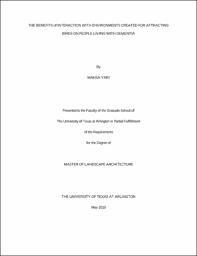
ATTENTION: The works hosted here are being migrated to a new repository that will consolidate resources, improve discoverability, and better show UTA's research impact on the global community. We will update authors as the migration progresses. Please see MavMatrix for more information.
Show simple item record
| dc.contributor.advisor | Allen, Diane Jones | |
| dc.creator | Yari, Mahsa | |
| dc.date.accessioned | 2019-05-28T23:04:18Z | |
| dc.date.available | 2019-05-28T23:04:18Z | |
| dc.date.created | 2019-05 | |
| dc.date.issued | 2019-05-06 | |
| dc.date.submitted | May 2019 | |
| dc.identifier.uri | http://hdl.handle.net/10106/28165 | |
| dc.description.abstract | In consideration of the increasing growth of people living with dementia, researchers have started to look at different interventions that help enhance their health and well-being. While the search for medical interventions is important, it is critical for other professions to consider how to contribute to the quality of care that dementia patients receive. Therapeutic landscapes can improve the overall care process for older adults with dementia living in long-term care facilities (i.e., dementia care homes) (Bossen 2010). While the landscape should be designed to help older adults with dementia, it should also create natural environments that attract birds that can further benefit health and well-being of this population. Due to the impact of the decline in cognitive functioning on older adults’ health and well-being, the purpose of this study is to summarize design guidelines for interactive landscapes between birds and older adults with dementia and provide design examples that benefit not only older adults with dementia but also a bird friendly habitat.
A comprehensive literature review was conducted to gather information for design guidelines that are specific for spaces that attract birds as well as for older adults with dementia. In addition, intensive telephone interviews with three bird experts from the Audubon Society have been conducted to understand the various aspects of the environment that helps create a healthy bird habitat.
Design guidelines for these specific purposes should focus on creating and maintaining healthy environments for birds that may increase multisensory experience of older adults with dementia. The present study also includes exemplary therapeutic garden designs that encourage the audience to explore spatial and ecological dimensions in the environments for older adults living with dementia as well as birds.
The results of this study have implications for landscape architects and designers who practice in healthcare and long-term care settings. In particular, courtyards in long-term care facilities need to be carefully designed and constructed with a focus on the special needs of older adults with this progressive disease. Also, utilizing birds and natural habitats, it is expected to develop more sustainable and healthy therapeutic spaces. | |
| dc.format.mimetype | application/pdf | |
| dc.language.iso | en_US | |
| dc.subject | Bird friendly garden | |
| dc.subject | Dementia garden | |
| dc.title | THE BENEFITS of INTERACTION WITH ENVIRONMENTS CREATED FOR ATTRACTING BIRDS ON PEOPLE LIVING WITH DEMENTIA | |
| dc.type | Thesis | |
| dc.degree.department | Landscape Architecture | |
| dc.degree.name | Master of Landscape Architecture | |
| dc.date.updated | 2019-05-28T23:04:19Z | |
| thesis.degree.department | Landscape Architecture | |
| thesis.degree.grantor | The University of Texas at Arlington | |
| thesis.degree.level | Masters | |
| thesis.degree.name | Master of Landscape Architecture | |
| dc.type.material | text | |
Files in this item
- Name:
- YARI-THESIS-2019.pdf
- Size:
- 4.511Mb
- Format:
- PDF
This item appears in the following Collection(s)
Show simple item record


